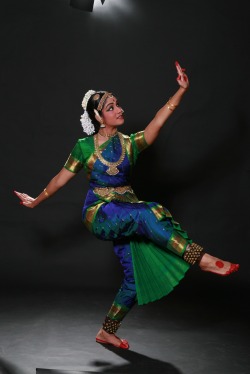Bharatanatyam
Introduction

Bharatanatyam is a classical theatre art of South India that is derived from Natyashastra, a 2,000-year-old Sanskrit treatise on the arts. It combines pure and expressional dance performed to Carnatic classical music. Initiation into this artistic tradition demands many years of training, hard work, dedication and discipline.
For more on the history of Bharatanatyam click here
Natya, Nritya, and Nritta

Natya - Vanquishing Evil
This dance form combines three aspects of dance: natya (narrative drama), nritya (expressional dance), and nritta (pure dance movements).
The Aesthetic Awakening

Nritta - Elegance in Complex Form
A Bharatanatyam performance aims to bring natya, nritya, and nritta into a harmonious balance, so that the spectators’ consciousness is transformed. This transformation is the experience of rasa, the ecstatic aesthetic relish that is the raison d’être of all Indian arts. In Sanskrit, rasa literally means ‘taste’, and it metaphorically describes the way an audience member vicariously ‘tastes’ the emotions brought to life during a performance.
In Indian culture, aesthetics are understood to express the esoteric. For the experience of rasa is a momentary transcendence of individual consciousness and grasping of the universal divine spirit. Thus, a Bharatanatyam dancer has the potential to take the audience for a tryst with the divine. This combination of spiritual ambition with technical achievement sets Bharatanatyam apart as the Indian dance par excellence.
In Indian culture, aesthetics are understood to express the esoteric. For the experience of rasa is a momentary transcendence of individual consciousness and grasping of the universal divine spirit. Thus, a Bharatanatyam dancer has the potential to take the audience for a tryst with the divine. This combination of spiritual ambition with technical achievement sets Bharatanatyam apart as the Indian dance par excellence.

